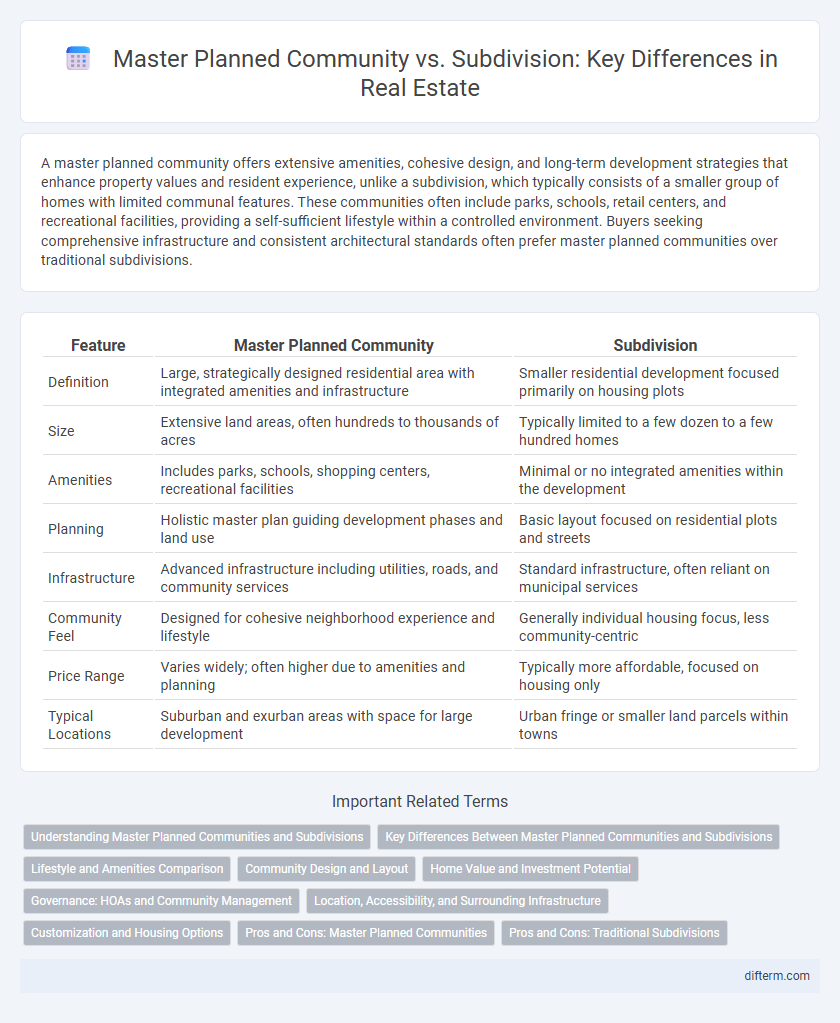A master planned community offers extensive amenities, cohesive design, and long-term development strategies that enhance property values and resident experience, unlike a subdivision, which typically consists of a smaller group of homes with limited communal features. These communities often include parks, schools, retail centers, and recreational facilities, providing a self-sufficient lifestyle within a controlled environment. Buyers seeking comprehensive infrastructure and consistent architectural standards often prefer master planned communities over traditional subdivisions.
Table of Comparison
| Feature | Master Planned Community | Subdivision |
|---|---|---|
| Definition | Large, strategically designed residential area with integrated amenities and infrastructure | Smaller residential development focused primarily on housing plots |
| Size | Extensive land areas, often hundreds to thousands of acres | Typically limited to a few dozen to a few hundred homes |
| Amenities | Includes parks, schools, shopping centers, recreational facilities | Minimal or no integrated amenities within the development |
| Planning | Holistic master plan guiding development phases and land use | Basic layout focused on residential plots and streets |
| Infrastructure | Advanced infrastructure including utilities, roads, and community services | Standard infrastructure, often reliant on municipal services |
| Community Feel | Designed for cohesive neighborhood experience and lifestyle | Generally individual housing focus, less community-centric |
| Price Range | Varies widely; often higher due to amenities and planning | Typically more affordable, focused on housing only |
| Typical Locations | Suburban and exurban areas with space for large development | Urban fringe or smaller land parcels within towns |
Understanding Master Planned Communities and Subdivisions
Master planned communities are large-scale residential developments designed with a comprehensive layout that includes amenities such as parks, schools, and retail centers, promoting a cohesive neighborhood environment. Subdivisions refer to smaller sections of land divided into individual plots primarily for residential use, often lacking the extensive infrastructure and community features of master planned communities. Understanding these distinctions helps buyers evaluate the lifestyle, investment value, and long-term growth potential associated with each type of development.
Key Differences Between Master Planned Communities and Subdivisions
Master planned communities feature a comprehensive design integrating residential, commercial, recreational, and educational spaces, offering residents a cohesive lifestyle with amenities like parks, schools, and shopping centers. Subdivisions primarily concentrate on residential development, often lacking integrated community features or extensive public amenities. These structural differences impact property values, community engagement, and long-term growth potential within each housing model.
Lifestyle and Amenities Comparison
Master planned communities offer an integrated lifestyle with diverse amenities such as parks, schools, retail centers, and recreational facilities designed for convenience and social engagement. Subdivisions typically provide residential lots with fewer shared amenities, often requiring residents to seek external options for entertainment and services. The comprehensive planning of master planned communities fosters a cohesive neighborhood experience, enhancing property value and resident satisfaction.
Community Design and Layout
Master planned communities feature a cohesive design with integrated amenities, green spaces, and well-planned infrastructure promoting a unified lifestyle. Subdivisions typically focus on residential lots with limited communal spaces, emphasizing individual property development. The community design in master planned developments fosters connectivity and diverse amenities, contrasting with the simpler, more segmented layout of subdivisions.
Home Value and Investment Potential
Master planned communities typically offer higher home values and stronger investment potential due to comprehensive amenities, cohesive design, and long-term community management. Subdivisions often lack these integrated features, which can limit appreciation rates and resale appeal. Investors prioritize master planned communities for their sustained demand, enhanced lifestyle options, and stability in property appreciation.
Governance: HOAs and Community Management
Master planned communities feature comprehensive governance structures through Homeowners Associations (HOAs) that oversee community-wide amenities, enforce design guidelines, and manage shared resources, ensuring consistent maintenance and long-term value. Subdivisions often have less centralized management, with smaller or no HOAs, resulting in limited oversight and varied enforcement of community standards. Effective community management in master planned areas enhances property values and resident satisfaction by fostering cohesive neighborhood development and sustained infrastructure upkeep.
Location, Accessibility, and Surrounding Infrastructure
Master planned communities offer comprehensive infrastructure, including schools, retail centers, and parks, designed cohesively within one area, often located near major highways and public transit for superior accessibility. Subdivisions generally focus on residential development with less integrated amenities, relying on nearby commercial zones and road networks that may vary in convenience. Location in master planned communities is strategically chosen to balance accessibility and lifestyle, whereas subdivisions can be scattered with varying proximity to essential services and transportation options.
Customization and Housing Options
Master planned communities offer extensive customization options and diverse housing types including single-family homes, townhouses, and apartments, designed with cohesive amenities and infrastructure. Subdivisions generally provide limited customization within a uniform housing style, focusing primarily on single-family homes. The variety and planning in master planned communities cater to a broader range of preferences and lifestyle needs compared to traditional subdivisions.
Pros and Cons: Master Planned Communities
Master planned communities offer extensive amenities, including parks, schools, and retail spaces, fostering a cohesive lifestyle and higher property values over time. Their well-thought-out infrastructure ensures long-term sustainability and aesthetic appeal, but higher HOA fees and restrictive regulations can limit homeowner flexibility. These developments attract diverse residents seeking organized neighborhood growth, though the large scale may reduce a sense of intimacy compared to smaller subdivisions.
Pros and Cons: Traditional Subdivisions
Traditional subdivisions offer established infrastructure and community amenities, providing convenience and connectivity for residents. However, they often lack the cohesive design and integrated green spaces found in master planned communities, potentially limiting long-term property value growth. Limited customization options and higher dependence on local zoning laws can restrict development flexibility within traditional subdivisions.
master planned community vs subdivision Infographic

 difterm.com
difterm.com